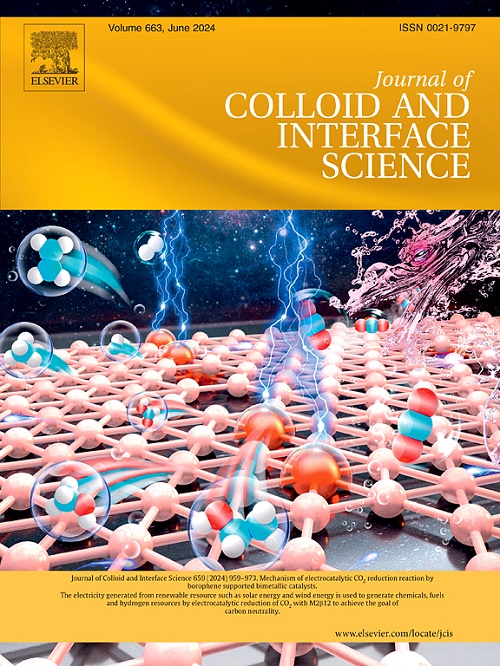Electrospun perovskite quantum dots-based Janus microribbons film with white light and multicolor luminescence for optical data storage and anti-counterfeiting
IF 9.7
1区 化学
Q1 CHEMISTRY, PHYSICAL
引用次数: 0
Abstract
In order to attain white light or multicolor luminescence of perovskite quantum dots (PQDs) materials, the prevalent method involves directly blending PQDs with different type and composition of halogen anions. However, this method allows uncontrolled halogen anion exchange between the different PQDs, thereby leading to alterations in the final fluorescence color of the material. To address this problem, we creatively design and fabricate a PQDs-based Janus microribbons film (Janus-MRF) with white light emission and multicolor fluorescence under multi-wavelength stimulation by a parallel electrospinning. [CsPbCl1.5Br1.5/Eu(BA)3phen/PS]//[CsPbBr3/Eu(BA)3phen/PS] (BA = benzoate radical, phen = 1,10-phenanthroline, PS = polystyrene) Janus microribbon (Janus-MR) serves as fundamental structural unit of Janus-MRF, CsPbCl1.5Br1.5 and CsPbBr3 PQDs respectively provide blue and green fluorescence, and Eu(BA)3phen offers red fluorescence. The introduction of Janus structure in Janus-MR allows the interior of the Janus-MR to form two independent microscopic domains, confining CsPbCl1.5Br1.5 PQDs and CsPbBr3 PQDs to their respective domains and avoiding halogen anion exchange caused by direct contact between the two PQDs and obtaining superior and designed macroscopic fluorescence. Owing to the disparity in optimal excitation wavelengths between PQDs and Eu(BA)3phen, white light and multicolor emissions of Janus-MRF can be achieved under multi-wavelength stimulation. Furthermore, the fluorescent color of Janus-MRF is sensitive to temperature changes. As an applicative demonstration of Janus-MRF, different sub-barcodes are obtained by using the identifiable fluorescence spectra emitted by Janus-MRF under multi-wavelength stimulation and the sensitivity of fluorescent color of Janus-MRF to temperature changes, and further these sub-barcodes are integrated into the large photonic barcodes encoding library for high-volume data storage and advanced anti-counterfeiting applications. This work provides a novel idea and strategy for advancing fabrication and application of materials based on PQDs.

基于钙钛矿量子点的白光多色Janus微带薄膜,用于光学数据存储和防伪
为了获得钙钛矿量子点材料的白光或多色发光,目前流行的方法是将钙钛矿量子点与不同类型和组成的卤素阴离子直接混合。然而,这种方法允许不同pqd之间不受控制的卤素阴离子交换,从而导致材料最终荧光颜色的改变。为了解决这一问题,我们创造性地设计并制备了一种在多波长刺激下具有白光发射和多色荧光的基于pqds的Janus微带膜(Janus- mrf)。[CsPbCl1.5Br1.5/Eu(BA)3phen/PS]//[CsPbBr3/Eu(BA)3phen/PS] (BA =苯甲酸基,phen = 1,10-菲罗啉,PS =聚苯乙烯)Janus微带(Janus- mr)是Janus- mrf的基本结构单元,CsPbCl1.5Br1.5和CsPbBr3 PQDs分别发出蓝色和绿色荧光,Eu(BA)3phen发出红色荧光。在Janus- mr中引入Janus结构,使Janus- mr内部形成两个独立的微观结构域,将CsPbCl1.5Br1.5 PQDs和CsPbBr3 PQDs限制在各自的结构域内,避免了两个PQDs直接接触引起的卤素阴离子交换,获得了优越的、设计好的宏观荧光。由于PQDs和Eu(BA)3phen的最佳激发波长存在差异,在多波长激励下,Janus-MRF可以产生白光和多色发射。此外,Janus-MRF的荧光颜色对温度变化很敏感。作为Janus-MRF的应用演示,利用Janus-MRF在多波长刺激下发出的可识别的荧光光谱和Janus-MRF荧光颜色对温度变化的敏感性,获得了不同的子条形码,并将这些子条形码集成到大型光子条形码编码库中,用于大容量数据存储和高级防伪应用。这项工作为推进pqd材料的制造和应用提供了新的思路和策略。
本文章由计算机程序翻译,如有差异,请以英文原文为准。
求助全文
约1分钟内获得全文
求助全文
来源期刊
CiteScore
16.10
自引率
7.10%
发文量
2568
审稿时长
2 months
期刊介绍:
The Journal of Colloid and Interface Science publishes original research findings on the fundamental principles of colloid and interface science, as well as innovative applications in various fields. The criteria for publication include impact, quality, novelty, and originality.
Emphasis:
The journal emphasizes fundamental scientific innovation within the following categories:
A.Colloidal Materials and Nanomaterials
B.Soft Colloidal and Self-Assembly Systems
C.Adsorption, Catalysis, and Electrochemistry
D.Interfacial Processes, Capillarity, and Wetting
E.Biomaterials and Nanomedicine
F.Energy Conversion and Storage, and Environmental Technologies

 求助内容:
求助内容: 应助结果提醒方式:
应助结果提醒方式:


